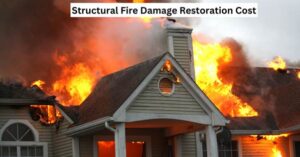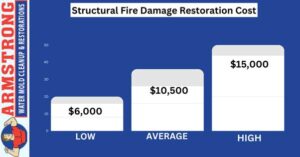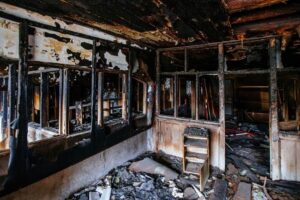
When a fire ravages your property, the financial burden can be overwhelming, but understanding the costs of repairing structural fire damage is crucial to plan.
Dealing with the aftermath of structural fire damage is never easy, but knowing what to expect regarding costs can alleviate some stress. Whether for insurance purposes or budgeting for repairs, having a clear breakdown of the expenses involved can help you make informed decisions. Read on to discover what goes into the structural fire damage cost and how it might impact your finances.
Cost Breakdown of Structural Fire Damage Restoration
| Cost Type | Estimated Amount (USD) |
| Low Cost | $6,000 |
| Average Cost | $10,500 |
| High Cost | $15,000 |

From Ashes to Rebuild: Uncovering the Real Cost of Structural Fire Damage Restoration.
| Service Type | Average Cost Range | What’s Included |
| Fire Damage Inspection | $300 – $600 | Inspection of the property, identifying structural integrity issues, and assessing safety hazards. |
| Board-Up and Securing | $500 – $1,500 | Temporary measures to secure the property, including boarding windows and doors. |
| Smoke Damage Cleanup | $1,000 – $3,500 | Removal of smoke odor and soot from walls, ceilings, and carpets, along with ventilation. |
| Structural Repair | $5,000 – $40,000 | Rebuilding walls, floors, and ceilings, along with reinforcing the structure to ensure safety. |
| Electrical System Repair | $1,000 – $5,000 | Replacing damaged electrical wiring, outlets, and systems to restore power functionality. |
| Plumbing Repairs | $500 – $3,000 | Fixing or replacing damaged pipes, water lines, and plumbing fixtures. |
Introduction
Understanding structural fire damage costs is essential when facing the aftermath of a fire. The structural fire damage cost can vary depending on the severity and scope of the damage. The structural fire damage price typically includes a combination of inspection, repair, and cleanup services. With these services, the cost of structural fire damage repair can range significantly, but knowing the charges of structural fire damage upfront helps in planning the restoration process efficiently.
Types of Structural Fire Damage Restoration
Structural Repair
Structural repairs focus on restoring the stability and safety of a fire-damaged property. Damaged components such as walls, ceilings, and flooring are either repaired or replaced to ensure the building’s structural integrity is uncompromised. This process often includes reinforcing load-bearing walls, replacing charred beams, and rebuilding critical areas to meet safety standards. These repairs are essential to make the property safe for habitation and prevent future complications.
Structural Framing Repairs
Structural framing serves as the backbone of your property, and fire damage can weaken its stability. Repairs involve replacing or reinforcing damaged beams, studs, and joists to ensure the building remains sound. This step is critical for restoring the overall structural integrity and preparing the space for further restoration work.
Foundation Damage Repair
A fire’s intense heat can crack or weaken the foundation, jeopardizing the entire structure. Foundation repairs may include filling cracks, sealing damages, or, in severe cases, rebuilding sections to stabilize the property. Proper foundation repair ensures long-term safety and prevents further structural issues.
Roof Structure Restoration
Fires often cause significant damage to roofs, weakening trusses, rafters, and decking. Roof structure restoration involves repairing or replacing damaged components and ensuring proper insulation and waterproofing. This step protects the property from external elements while maintaining structural stability.
Wall and Floor Repairs
Walls and floors are often the most visibly damaged components in a fire. Repairs include replacing charred drywall, refinishing floors, and addressing structural supports within walls. Restoring these elements not only enhances the property’s appearance but also reinforces its safety and usability.
Load-Bearing Wall Repairs
Fire damage to load-bearing walls can compromise a building’s stability. Repairing these walls involves replacing weakened materials and reinforcing them with fire-resistant upgrades. This ensures the structure can support its intended weight and maintain safety.
Structural Causes and Effects of Fire Damage Restoration
| Cause | Effect on Structure | Restoration Approach |
| Heat Damage | Warped or weakened walls, ceilings, and beams. | Replacing or reinforcing damaged structural components with fire-resistant materials. |
| Smoke and Soot Residue | Penetration into walls, ceilings, and insulation, causes discoloration and odors. | Deep cleaning, soot removal, and sealing porous materials to eliminate smoke damage. |
| Water Damage (from firefighting) | Rotted wood, mold growth, and weakened flooring or walls due to excessive moisture. | Drying and dehumidifying affected areas, replacing water-damaged materials, and applying mold prevention. |
| Direct Fire Damage | Complete charring or destruction of walls, floors, roofs, and structural components. | Removing and replacing severely damaged sections, rebuilding key structural elements, and ensuring stability. |
| Foundation Stress | Cracks and structural instability are caused by intense heat or firefighting efforts. | Repairing foundation cracks, applying sealants, or rebuilding sections for stability. |
| Electrical System Damage | Melted wires, damaged circuits, and risk of electrical fires post-recovery. | Inspecting, replacing wiring, and ensuring compliance with electrical safety standards. |
| Metal Component Damage | Warping, buckling, or corrosion in metal supports due to heat exposure. | Replacing or reinforcing compromised metal elements with fire-resistant alternatives. |
| Compromised Roof Structure | Collapsed or unstable roof due to fire and heat damage to trusses and beams. | Rebuilding roof supports, replacing damaged decking, and ensuring waterproofing. |
Fire Strikes Hard, But What Will It Cost to Restore Your Home?
Structural Fire Damage Restoration Cost vs other types of fire restoration cost
| Service Type | Average Cost (USD) | Description |
| Structural Fire Damage Restoration cost | $6,000 – $15,000 | Includes repairing or replacing walls, ceilings, floors, and insulation affected by fire or heat. |
| Contents Fire Damage Restoration cost | $1,500 – $5,000 | Restores furniture, electronics, clothing, and personal belongings affected by smoke, soot, or heat. |
| Electrical Fire Damage Restoration cost | $3,500 – $12,000 | Repairs or replaces electrical systems, wiring, and appliances damaged by fire. |
| Third-Party Fire Damage Restoration cost | $10,000 – $25,000 | Cost for hiring independent professionals to oversee and manage the fire restoration process. |
| Fire or Heat Damage Restoration cost | $4,000 – $12,000 | Focuses on repairing areas affected by intense heat, even if not directly on fire. |
| Smoke Damage Restoration cost | $2,000 – $6,000 | Cleaning and deodorizing smoke residue from walls, furniture, and fabrics. |
| Air Quality Restoration cost | $1,500 – $4,000 | Removes airborne contaminants and odors from the building, ensuring safe air quality post-fire. |
Final Remarks

Understanding the structural fire damage cost is crucial for planning your property’s recovery after a fire. From inspecting damages to repairing foundations, roofs, and walls, every step of the restoration process contributes to rebuilding safety and functionality. Costs vary depending on the extent of damage, but with expert help, you can restore your property efficiently. Don’t leave your recovery to chance—consult with professionals today to get an accurate structural fire damage price estimate.
Click here for a consultation and let experts guide you through every step of the restoration process.
FAQs
The average cost ranges from $6,000 to $15,000, depending on the extent of the damage.
Yes, most insurance policies cover restoration costs, but check your policy for specific terms. excluded.
Restoration can take a few weeks to several months, depending on the severity of the damage.
Services typically include damage assessment, debris removal, structural repairs, smoke cleanup, and plumbing or electrical fixes.
DIY is not recommended for structural repairs. Professional expertise is essential for safety and compliance with building codes.
